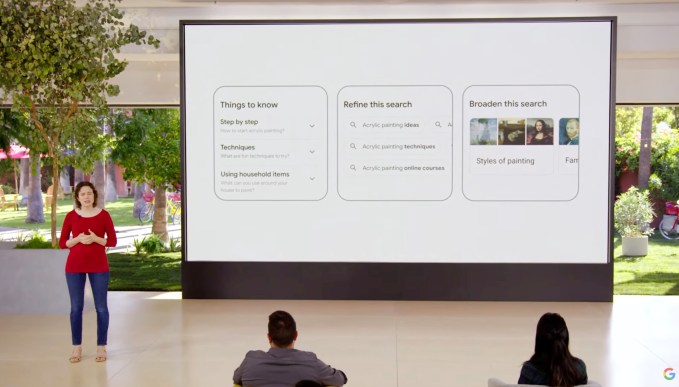Google announced today it will be applying AI advancements, including a new technology called Multitask Unified Model (MUM) to improve Google Search. At the company’s Search On event, the company demonstrated new features, including those that leverage MUM, to better connect web searchers to the content they’re looking for, while also making web search feel more natural and intuitive.
One of the features being launched is called “Things to know,” which will focus on making it easier for people to understand new topics they’re searching for. This feature understands how people typically explore various topics and then shows web searchers the aspects of the topic people are most likely to look at first.

Image Credits: Google
For example, Google explained, if you were searching for “acrylic painting,” it may suggest “Things to know” like how to get started with painting, step-by-step, or the different styles of acrylic painting, tips about acrylic painting, how to clean acrylic paint, and more. In this example, Google is able to identify over 350 different topics related to acrylic painting, it notes.
This feature will launch in the coming months, but Google notes it will also be expanded in the future by using MUM to help web users unlock even deeper insights into the topic beyond what they may have thought to look for — like “how to make acrylic paintings with household items.”

Image Credits: Google
The company is also developing new ways to help web users both refine and broaden their searches without having to start over with a new query.
To continue the acrylic painting example, Google may offer to connect you to information about specific painting techniques, like puddle pouring, or art classes you could take. You could then zoom into one of those other topics in order to see a visually rich page of search results and ideas from across the web, including articles, images, videos and more.

Image Credits: Google
These pages are meant to better compete with Pinterest, it seems, as they’re also able to help people become inspired by searches — similar to how Pinterest’s image-heavy pinboard aims to turn people’s visual inspiration into action — like visiting a website or making an online purchase.
Google says the pages will be useful for searches where users are “looking for inspiration,” like “Halloween decorating ideas” or “indoor vertical garden ideas” or other ideas to try. This feature can be tried out today on mobile devices.
Google is also upgrading video search. Already, the company uses AI to identify key moments inside a video. Now, it will take things further with the launch of a feature that will identify the topics in a video — even if the topic isn’t explicitly mentioned in the video — then provide links that allow users to dig deeper and learn more.

Image Credits: Google
That means when you’re watching a YouTube video, MUM will be used to understand what the video is about and make suggestions. In an example, a video about Macaroni penguins may point users to a range of related videos, like those that talk about how Macaroni penguins find their family members and navigate predators. MUM can identify these terms to search for, even if they’re not explicitly said in the video.
This feature will roll out in an initial version on YouTube Search in the weeks ahead, and will be updated to include more visual enhancements in the coming months, says Google.
This change could also help to drive increased search traffic to Google, by leveraging YouTube’s sizable reach. Many Gen Z users already search for online content differently than older generations, studies have found. They tend to use multiple social media channels, have a mobile-first mindset and are engaged with video content. A “Think with Google” study, for instance, found that 85% of Gen Z teenagers would use YouTube regularly to find content, while 80% said YouTube videos had successfully taught them something. Other data had demonstrated that Gen Z prefers to learn about new ideas and products through video as well, not text, native ads or other content formats.
For Google, this sort of addition may be necessary because the shift to mobile is impacting its search dominance. Today, many mobile shopping searches today now start directly on Amazon. Plus, when iPhone users need to do something specific on their phone, they often turn to Siri, Spotlight, the App Store, or a native app to get help.
Google also today unveiled how it’s using MUM technology to improve visual searches using Google Lens.
